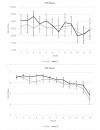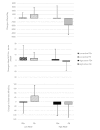Evaluating Motivational Interviewing and Habit Formation to Enhance the Effect of Activity Trackers on Healthy Adults' Activity Levels: Randomized Intervention
- PMID: 30762582
- PMCID: PMC6393778
- DOI: 10.2196/10988
Evaluating Motivational Interviewing and Habit Formation to Enhance the Effect of Activity Trackers on Healthy Adults' Activity Levels: Randomized Intervention
Abstract
Background: While widely used and endorsed, there is limited evidence supporting the benefits of activity trackers for increasing physical activity; these devices may be more effective when combined with additional strategies that promote sustained behavior change like motivational interviewing (MI) and habit development.
Objective: This study aims to determine the utility of wearable activity trackers alone or in combination with these behavior change strategies for promoting improvements in active and sedentary behaviors.
Methods: A sample of 91 adults (48/91 female, 53%) was randomized to receive a Fitbit Charge alone or in combination with MI and habit education for 12 weeks. Active and sedentary behaviors were assessed pre and post using research-grade activity monitors (ActiGraph and activPAL), and the development of habits surrounding the use of the trackers was assessed postintervention with the Self-Reported Habit Index. During the intervention, Fitbit wear time and activity levels were monitored with the activity trackers. Linear regression analyses were used to determine the influence of the trial on outcomes of physical activity and sedentary time. The influence of habits was examined using correlation coefficients relating habits of tracker use (wearing the tracker and checking data on the tracker and associated app) to Fitbit wear time and activity levels during the intervention and at follow-up.
Results: Regression analyses revealed no significant differences by group in any of the primary outcomes (all P>.05). However, personal characteristics, including lower baseline activity levels (beta=-.49, P=.01) and lack of previous experience with pedometers (beta=-.23, P=.03) were predictive of greater improvements in moderate and vigorous physical activity. Furthermore, for individuals with higher activity levels at the baseline, MI and habit education were more effective for maintaining these activity levels when compared with receiving a Fitbit alone (eg, small increase of ~48 steps/day, d=0.01, vs large decrease of ~1830 steps/day, d=0.95). Finally, habit development was significantly related to steps/day during (r=.30, P=.004) and following the intervention (r=.27, P=.03).
Conclusions: This study suggests that activity trackers may have beneficial effects on physical activity in healthy adults, but benefits vary based on individual factors. Furthermore, this study highlights the importance of habit development surrounding the wear and use of activity trackers and the associated software to promote increases in physical activity.
Trial registration: ClinicalTrials.gov NCT03837366; https://clinicaltrials.gov/ct2/show/NCT03837366.
Keywords: activity tracker; habit; mHealth; mobile phone; motivational interviewing; physical activity; wearable electronic devices.
©Laura D Ellingson, Jeni E Lansing, Kathryn J DeShaw, Karissa L Peyer, Yang Bai, Maria Perez, L Alison Phillips, Gregory J Welk. Originally published in JMIR Mhealth and Uhealth (http://mhealth.jmir.org), 14.02.2019.
Conflict of interest statement
Conflicts of Interest: None declared.
Figures




Similar articles
-
Estimating Physical Activity and Sedentary Behavior in a Free-Living Context: A Pragmatic Comparison of Consumer-Based Activity Trackers and ActiGraph Accelerometry.J Med Internet Res. 2016 Sep 7;18(9):e239. doi: 10.2196/jmir.5531. J Med Internet Res. 2016. PMID: 27604226 Free PMC article. Clinical Trial.
-
Interest and preferences for using advanced physical activity tracking devices: results of a national cross-sectional survey.BMJ Open. 2016 Jul 7;6(7):e011243. doi: 10.1136/bmjopen-2016-011243. BMJ Open. 2016. PMID: 27388359 Free PMC article.
-
Habit Formation in Wearable Activity Tracker Use Among Older Adults: Qualitative Study.JMIR Mhealth Uhealth. 2021 Jan 19;9(1):e22488. doi: 10.2196/22488. JMIR Mhealth Uhealth. 2021. PMID: 33464216 Free PMC article.
-
Consumer-Based Wearable Activity Trackers Increase Physical Activity Participation: Systematic Review and Meta-Analysis.JMIR Mhealth Uhealth. 2019 Apr 12;7(4):e11819. doi: 10.2196/11819. JMIR Mhealth Uhealth. 2019. PMID: 30977740 Free PMC article.
-
Effects of Motivational Interviewing and Wearable Fitness Trackers on Motivation and Physical Activity: A Systematic Review.Am J Health Promot. 2021 Feb;35(2):226-235. doi: 10.1177/0890117120939030. Epub 2020 Jul 14. Am J Health Promot. 2021. PMID: 32662277
Cited by
-
Identifying App-Based Meditation Habits and the Associated Mental Health Benefits: Longitudinal Observational Study.J Med Internet Res. 2021 Nov 4;23(11):e27282. doi: 10.2196/27282. J Med Internet Res. 2021. PMID: 34734826 Free PMC article.
-
Comparison of two portable metabolic systems for measuring energy expenditure at rest and during exercise in untrained women.Front Physiol. 2025 Jul 1;16:1583703. doi: 10.3389/fphys.2025.1583703. eCollection 2025. Front Physiol. 2025. PMID: 40666118 Free PMC article.
-
Medication adherence in youths with CKD: habits for success.Pediatr Nephrol. 2023 Nov;38(11):3791-3802. doi: 10.1007/s00467-023-05976-0. Epub 2023 Jun 12. Pediatr Nephrol. 2023. PMID: 37306720 Free PMC article. Clinical Trial.
-
Effects of a 12-Week Multifaceted Wearable-Based Program for People With Knee Osteoarthritis: Randomized Controlled Trial.JMIR Mhealth Uhealth. 2020 Jul 3;8(7):e19116. doi: 10.2196/19116. JMIR Mhealth Uhealth. 2020. PMID: 32618578 Free PMC article. Clinical Trial.
-
Is telerehabilitation an effective maintenance strategy for patients with chronic obstructive pulmonary diseases: a systematic review.Bull Natl Res Cent. 2023;47(1):13. doi: 10.1186/s42269-023-00980-8. Epub 2023 Feb 1. Bull Natl Res Cent. 2023. PMID: 36743313 Free PMC article. Review.
References
-
- Bogaty S. 2015. [2015-11-30]. The demographic divide: Fitness trackers and smartwatches attracting very different segments of the market, according to the NPD group Internet https://www.npd.com/wps/portal/npd/us/news/press-releases/2015/the-demog... .
-
- Llamas R. IDC Media Center. [2018-11-22]. Worldwide Wearables Market to Nearly Double by 2021, According to IDC Internet https://www.idc.com/getdoc.jsp?containerId=prUS42818517 .
-
- Witkowski W. marketwatch. [2018-01-16]. Smartwatch growth surges ahead of Apple, Fitbit offerings - MarketWatch Internet https://www.marketwatch.com/story/smartwatch-growth-surges-ahead-of-appl... .

